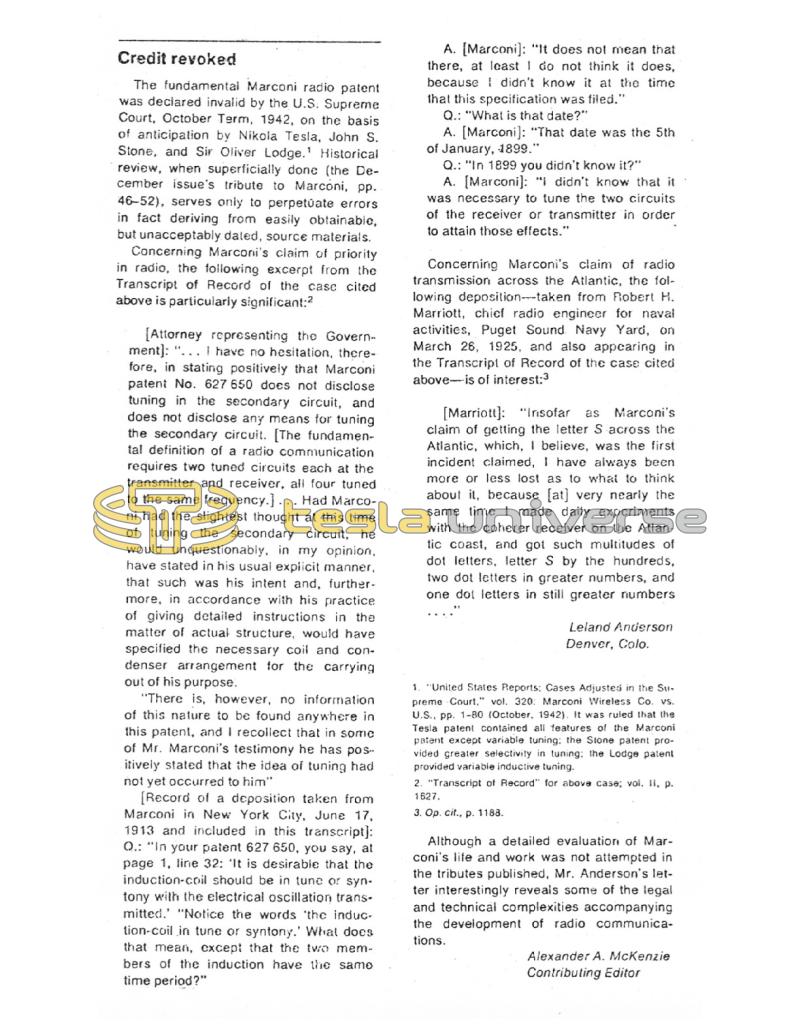
Nikola Tesla Articles
Credit revoked
The fundamental Marconi radio patent was declared invalid by the U.S. Supreme Court, October Term, 1942, on the basis of anticipation by Nikola Tesla, John S. Stone, and Sir Oliver Lodge.1 Historical review, when superficially done (the December issue's tribute to Marconi, pp. 46-52), serves only to perpetuate errors in fact deriving from easily obtainable, but unacceptably dated, source materials. Concerning Marconi's claim of priority. in radio, the following excerpt from the Transcript of Record of the case cited above is particularly significant:2
[Attorney representing the Government]: "... I have no hesitation, therefore, in stating positively that Marconi patent No. 627 650 does not disclose tuning in the secondary circuit, and does not disclose any means for tuning the secondary circuit. [The fundamental definition of a radio communication requires two tuned circuits each at the transmitter and receiver, all four tuned to the same frequency.]... Had Marconi had the slightest thought at this time of tuning the secondary circuit, he would unquestionably, in my opinion, have stated in his usual explicit manner, that such was his intent and, furthermore, in accordance with his practice of giving detailed instructions in the matter of actual structure, would have specified the necessary coil and condenser arrangement for the carrying out of his purpose.
"There is, however, no information of this nature to be found anywhere in this patent, and I recollect that in some of Mr. Marconi's testimony he has positively stated that the idea of tuning had not yet occurred to him"
[Record of a deposition taken from Marconi in New York City, June 17, 1913 and included in this transcript]: Q.: "In your patent 627 650, you say, at page 1, line 32: 'It is desirable that the induction-coil should be in tune or syntony with the electrical oscillation transmitted. "Notice the words the induction-coil in tune or syntony.' What does that mean, except that the two members of the induction have the same time period?" A. [Marconi]: "It does not mean that there, at least I do not think it does, because I didn't know it at the time that this specification was filed." Q.: "What is that date?" A. [Marconi]: "That date was the 5th of January, 1899." Q.: "In 1899 you didn't know it?" A. [Marconi]: "I didn't know that it was necessary to tune the two circuits of the receiver or transmitter in order to attain those effects."
Concerning Marconi's claim of radio transmission across the Atlantic, the following deposition-taken from Robert H. Marriott, chief radio engineer for naval activities, Puget Sound Navy Yard, on March 26, 1925, and also appearing in the Transcript of Record of the case cited above is of interest:3
[Marriott]: "Insofar as Marconi's claim of getting the letter S across the Atlantic, which, I believe, was the first incident claimed, I have always been more or less lost as to what to think about it, because [at] very nearly the same time I made daily experiments with the coherer receiver on the Atlantic coast, and got such multitudes of dot letters, letter S by the hundreds, two dot letters in greater numbers, and one dot letters in still greater numbers..."
Leland Anderson
Denver, Colo.
1. "United States Reports; Cases Adjusted in the Supreme Court," vol. 320: Marconi Wireless Co. vs. U.S., pp. 1-80 (October, 1942). It was ruled that the Tesla patent contained all features of the Marconi patent except variable tuning: the Stone patent provided greater selectivity in tuning: the Lodge patent provided variable inductive tuning.
2. "Transcript of Record" for above case; vol. II, p. 1627.
3. Op. cit., p. 1188.
Although a detailed evaluation of Marconi's life and work was not attempted in the tributes published, Mr. Anderson's letter interestingly reveals some of the legal and technical complexities accompanying the development of radio communications.
Alexander A. McKenzie
Contributing Editor
